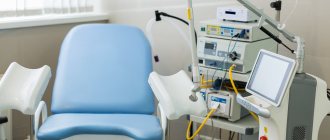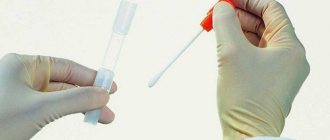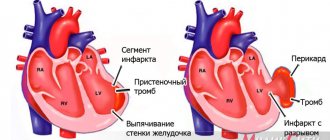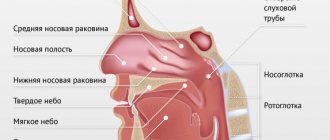Discharge from the mammary glands (when pressed or spontaneously) causes discomfort and a feeling of anxiety. This phenomenon can be caused by both natural physiological processes and pathology. Discharge from the breast can occur on its own or with pressure, during or after lactation. These factors play an important role and allow the doctor to determine the cause of the problem.
The main thing is to promptly identify dangerous symptoms that require medical intervention.
In any case, you should not engage in self-diagnosis and self-medication. If you have any suspicions, consult your doctor.
Discharge from the mammary glands when pressed
In most cases, discharge is observed due to physical pressure on the chest. During pregnancy and lactation, discharge from the mammary gland when pressed is considered normal if it is not accompanied by acute pain, increased body temperature and blood. Also, do not worry if secretions are released after nipple stimulation. As excitation increases, the gland begins to work more actively. In other cases, you need to contact a specialist who will make an accurate diagnosis and prescribe effective therapy. The main causes of unpleasant symptoms are the following diseases:
- Oncology. A malignant tumor in the mammary gland causes discomfort or pain in the breasts, redness of the skin, changes in the shape of the nipples and bloody discharge.
- Intraductal papilloma. It is a benign formation arising from the epithelium of the mammary gland. Among the main symptoms, it is worth noting painful sensations on palpation, as well as clear, white, green or yellow discharge mixed with blood.
- Hormonal disbalance. This disorder occurs due to pregnancy or taking contraceptives. The discharge may be clear or in the form of colostrum.
- Mastitis. It is an acute inflammatory process in the mammary gland, which in most cases is provoked by a staphylococcal infection. From the first days of the disease, the patient feels unwell, fever and pain in the breast area. If left untreated, purulent discharge with a greenish tint may appear.
- Ectasia of the milk ducts. This is an age-related or pathological expansion of the milk ducts, accompanied by an inflammatory process, pain, itching and dark green discharge from the mammary glands when pressed.
These diseases can progress quickly and move into a more severe stage. Effective treatment at the initial stage will avoid serious consequences.
Surgical intervention
Surgical intervention is also required if intraductal papilloma is found. The affected area should be removed. The removed particles are subjected to histological examination to reliably exclude the malignant nature of the papilloma. For Paget's disease, a mastectomy is prescribed, which involves removing the affected gland. Next, chemotherapy sessions are prescribed.
Discharge during pregnancy
Changes in the breasts begin to occur starting in early pregnancy. In addition to an increase in size and increased sensitivity, discharge may appear. This is a natural process.
The mammary glands are actively preparing for lactation and producing colostrum. This is a yellow-tinged liquid that appears in all women at different stages of pregnancy. If the discharge is bloody or accompanied by painful sensations, you should consult a specialist to rule out possible health problems.
Main manifestations
The main manifestations of mastopathy include:
- green discharge from the glands;
- spotting (in advanced stages);
- aching, dull pain before the onset of menstruation;
- breast swelling;
- compactions that can be detected upon palpation;
- increase in the size of lymph nodes.
Mastopathy is a benign change in gland tissue that is directly dependent on neurohumoral regulation. This means that the factors in the development of this disease are both pathologies caused by disturbances in the functioning of nervous regulation (neuroses, stress, depression), and changes in the hormonal balance and homeostasis of the body.
Discharge outside of pregnancy
In the absence of pregnancy, discharge can appear for many reasons. The main ones are hormonal disorders, injuries, benign and malignant formations, as well as inflammatory processes. In any of these cases, qualified treatment is required. To establish a diagnosis, the doctor conducts an examination, prescribes tests and other types of examination. Self-medication can lead to deterioration of well-being and also jeopardize the health and life of the patient.
Oncological disease
Breast cancer is the presence of a malignant neoplasm. Local manifestations of this disease are: changes in the shape of the gland, retraction of the nipple, bloody or green discharge from the breast in women, wrinkling of the skin, palpation of nodules, seals, enlargement of the axillary or supraclavicular lymph nodes. In the early stages of the pathological process, surgical treatment in combination with chemotherapy is most effective. In the later stages of the disease, metastasis of atypical cells develops in various organs.
Dangerous symptoms
Discharge from the chest is always accompanied by certain symptoms and characteristics. This allows you to make a preliminary diagnosis and determine a further diagnostic plan. Among the dangerous symptoms it is worth highlighting:
- Bloody issues. They are a sign of an acute inflammatory process, trauma, as well as malignant and benign formations.
- Increased temperature, enlarged mammary glands and purulent discharge are signs of mastitis.
- Yellow or green discharge may be a consequence of fibrocystic mastopathy.
Treatment methods
Treatment tactics are determined by the doctor after examination
. In order to completely eliminate discharge with purulent contents from the mammary glands, it is necessary to complete a full course of treatment prescribed after diagnosing the underlying disease. Otherwise, the appearance of purulent secretion will recur after a short time, and the pathological process may become chronic and cause the development of breast cancer.
The main treatment options for purulent discharge are divided into three groups - conservative, surgical or puncture, which involves pumping out the purulent contents. The age and condition of the patient’s body, the neglect of the pathological process, the presence of other diseases and other clinical reasons are taken into account.
Certain diseases, the symptom of which is the appearance of purulent discharge from the chest, require specific treatment methods:
- For ectasia, antibacterial therapy is carried out or the method of excision of the milk canal with identified pathology is used.
- If there is an inflammatory process with the formation of an abscess, the latter is opened, after which the patient is prescribed a course of anti-inflammatory drugs.
- For mastitis, the patient is prescribed a conservative course of treatment or undergoes surgery.
- In Paget's disease, either part of the breast with the tumor or the entire breast is removed.
For intraductal papilloma, the only treatment option is excision of the affected tissue followed by a biopsy to clarify the nature of the neoplasm.
Natural and non-hazardous discharge
There are a number of situations when discharge from the mammary glands is a natural physiological process that does not pose a threat to health. These include:
- Colostrum during pregnancy. The main function of the mammary glands is to produce milk to feed the baby. During pregnancy, the hormone prolactin is activated, which provokes the appearance of a special secretion in the alveoli - colostrum. It has a thick structure and is yellow in color.
- Small transparent discharge from the mammary glands when pressed (stimulating the nipples) may be a secretion. Any gland in the human body secretes a secretion, the mammary glands are no exception.
Thus, normal discharge includes colostrum during pregnancy and the appearance of clear liquid when the nipples are stimulated. In other cases, you should immediately consult a doctor to identify the problem and undergo treatment.
Diagnostics
The primary examination of women with complaints of nipple discharge is carried out by a specialist mammologist. The doctor selects laboratory and instrumental methods, which are primarily aimed at studying the condition of the mammary glands, identifying suspicious structural changes or signs of inflammation. The following studies have the greatest diagnostic value:
- Ultrasound scanning
. Using sonography, breast tissue is visualized, structural abnormalities and space-occupying formations are detected. The method is absolutely safe, so it is prescribed even to pregnant women. Ultrasound of the mammary glands is more often used in young women, since their breasts have a dense structure that is clearly visible during the examination. - Mammography
. An X-ray examination of the breast is aimed at detecting tumors or fibrous changes that could cause secretions to leak from the nipples. The method is more informative after 40 years. To clarify the diagnosis, mammography is supplemented with ductography - contrasting the milk ducts. - Breast biopsy
. If there is a volumetric shadow, a fine-needle biopsy or trephine biopsy of the breast under the control of an ultrasound machine is used. The obtained biopsies are sent for cytomorphological analysis to determine the cellular composition and possible signs of malignancy. - Study of secretions
. When purulent or cloudy serous secretion has leaked, inoculation of the discharge into nutrient media is indicated. The method is necessary to identify the pathogenic agent. Additionally, the sensitivity of microbes to antibiotics is studied. Be sure to do a guaiac test, which helps eliminate bleeding from the chest. - Blood tests
. In addition to standard laboratory tests, in case of complaints about secretion from the nipples, the level of sex hormones and prolactin in the blood is determined. To exclude neoplasia, a blood test is prescribed for the main tumor markers. Advanced biochemical analysis makes it possible to identify signs of the inflammatory process.
If indicated, MRI mammography is performed to clarify the diagnosis. If nipple discharge has an unclear etiology, targeted radiography of the sella turcica, CT and MRI of the brain are recommended to exclude pathologies of the hypothalamic-pituitary zone. Taking into account the detected changes, consultations with other specialists (endocrinologist, oncologist) may be required.
Cytology of nipple discharge
Characteristic signs of cancer
The manifestations of the disease differ significantly from other forms of oncology in that they allow early suspicion of the development of a malignant process. Breast cancer is characterized by:
- discharge of blood or pathological secretion from the nipple, predominantly green or gray in color;
- the appearance of crusts or scales on the areola or nipple, the formation of superficial erosion or cracks in the nipple area;
- increase in the affected area;
- formation of a painless lump deep in the mammary gland;
- retraction and deepening of the nipple;
- in 85% of cases, women have no pain, sometimes there is itching or tingling in the chest.
Actinomycosis
This disease is characterized by chronic specific damage to the mammary glands; it is a form of visceral mycosis that occurs with the formation of abscesses and granulomas. The clinical picture of actinomycosis is characterized by the formation of individual nodes, then ulcers, which open with the development of long-term non-healing fistulas. In mammology, this disease is quite rare - approximately 0.05-0.1% of all cases of inflammatory pathologies of the mammary glands. Attribution of the disease to the group of mycoses is very conditional; it is based on the morphological similarity of the infectious pathogen with fungi and the course characteristic of the mycotic lesion. The causative agents of this pathological process are actinomycetes (radiant fungi), which are bacterial cells. Actinomycosis affects one or both glands and is accompanied by the formation of multiple or single ulcers.
In most cases, patients note the appearance of small hyperemic nodules in the nipple area, which later transform into painful dense infiltrates, and then into ulcers. The skin over them turns purple. In the area of opened abscesses of the gland, fistulous tracts are formed, from which pus periodically emerges. Along with these manifestations, patients are often bothered by discharge from the nipples when pressed - they are often greenish in color and may contain pus. A woman experiences chest pain, and sometimes her body temperature rises.










